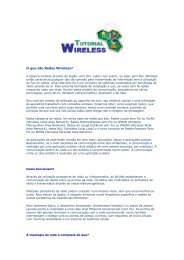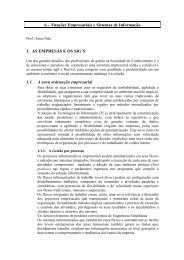Create successful ePaper yourself
Turn your PDF publications into a flip-book with our unique Google optimized e-Paper software.
• IPsec Protocol (ESP or AH)<br />
• Security Parameters Index<br />
In many ways this triple can be likened to an IP socket, which is uniquely<br />
denoted by the remote IP address, protocol, and port number.<br />
Security Associations are one way, so a two-way connection (the typical case)<br />
requires at least two. Furthermore, each protocol (ESP/AH) has its own SA in<br />
each direction, so a full AH+ESP VPN requires four Security Associations. These<br />
are all kept in the Security Associations Database.<br />
A tremendous amount of information is kept in the SADB, and we can only touch<br />
on a few of them:<br />
• AH: authentication algorithm<br />
• AH: authentication secret<br />
• ESP: encryption algorithm<br />
• ESP: encryption secret key<br />
• ESP: authentication enabled yes/no<br />
• Many key-exchange parameters<br />
• Routing restrictions<br />
• IP filtering policy<br />
Some implementations maintain the SPD (Security Policy Database) with<br />
command-line tools, others with a GUI, while others provide a web-based<br />
interface over the network. The amount of detail maintained by any particular<br />
implementation depends on the facilities offered, as well as whether it's<br />
operating in Host or Gateway mode (or both).<br />
Key Management<br />
Finally, we briefly visit the very complex matter of key management. This area<br />
includes several protocols and many options, and the bulk of this will be covered<br />
in a future paper. This section is necessarily highly incomplete.<br />
IPsec would be nearly useless without the cryptographic facilities of<br />
authentication and encryption, and these require the use of secret keys known to<br />
the participants but not to anyone else.<br />
The most obvious and straightforward way to establish these secrets is via<br />
manual configuration: one party generates a set of secrets, and conveys them to<br />
all the partners. All parties install these secrets in their appropriate Security<br />
Associations in the SPD.<br />
But this process does not scale well, nor is it always terribly secure: the mere act<br />
of conveying the secrets to another site's SPD may well expose them in transit. In<br />
a larger installation with many devices using the same preshared key,<br />
compromise of that key makes for a very disruptive re-deployment of new keys.<br />
IKE — Internet Key Exchange — exists to allow two endpoints to properly set up<br />
their Security Associations, including the secrets to be used. IKE uses the<br />
ISAKMP (Internet Security Association Key Management Protocol) as a













![Plano de Contabilidade Social 2013[1].pdf - FESP](https://img.yumpu.com/40657716/1/184x260/plano-de-contabilidade-social-20131pdf-fesp.jpg?quality=85)



